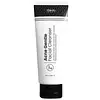What's inside
What's inside
 Key Ingredients
Key Ingredients

 Benefits
Benefits

 Concerns
Concerns

 Ingredients Side-by-side
Ingredients Side-by-side

Water
Skin ConditioningPEG-7 Glyceryl Cocoate
EmulsifyingMyristic Acid
CleansingGlycerin
HumectantPalmitic Acid
EmollientStearic Acid
CleansingPEG-400
Emulsion StabilisingCocamide DEA
EmulsifyingTriethanolamine
BufferingSodium Laureth Sulfate
CleansingSulfur
AntiseborrhoeicSalicylic Acid
MaskingSynthetic Wax
AbrasiveSodium Hydroxide
BufferingParfum
MaskingPropylene Glycol
HumectantDiazolidinyl Urea
PreservativeXylitylglucoside
HumectantMethylparaben
PreservativeXanthan Gum
EmulsifyingDisodium EDTA
Anhydroxylitol
HumectantCaprylic/Capric Glycerides
EmollientXylitol
HumectantCI 47005
Cosmetic ColorantCellulose Gum
Emulsion StabilisingPropylparaben
PreservativeCI 42090
Cosmetic ColorantGlucose
HumectantCI 77499
Cosmetic ColorantWater, PEG-7 Glyceryl Cocoate, Myristic Acid, Glycerin, Palmitic Acid, Stearic Acid, PEG-400, Cocamide DEA, Triethanolamine, Sodium Laureth Sulfate, Sulfur, Salicylic Acid, Synthetic Wax, Sodium Hydroxide, Parfum, Propylene Glycol, Diazolidinyl Urea, Xylitylglucoside, Methylparaben, Xanthan Gum, Disodium EDTA, Anhydroxylitol, Caprylic/Capric Glycerides, Xylitol, CI 47005, Cellulose Gum, Propylparaben, CI 42090, Glucose, CI 77499
Water
Skin ConditioningCocamidopropyl Betaine
CleansingGlycerin
HumectantSodium C14-18 Olefin Sulfonate
CleansingLactic Acid
BufferingDecyl Glucoside
CleansingPEG-150 Distearate
EmulsifyingPotassium Hydroxide
BufferingMethyl Gluceth-20
HumectantDisodium Cocoyl Glutamate
CleansingPhenoxyethanol
PreservativeSodium Chloride
MaskingHydroxypropyl Methylcellulose
Emulsion StabilisingSalicylic Acid
MaskingSuccinic Acid
BufferingPropylene Glycol
HumectantArginine
MaskingSodium PCA
HumectantButylene Glycol
HumectantAloe Barbadensis Leaf Extract
EmollientTetrasodium EDTA
Sodium Sulfate
Ethylhexylglycerin
Skin ConditioningCamellia Sinensis Extract
AntioxidantCentella Asiatica Leaf Extract
Skin ConditioningWater, Cocamidopropyl Betaine, Glycerin, Sodium C14-18 Olefin Sulfonate, Lactic Acid, Decyl Glucoside, PEG-150 Distearate, Potassium Hydroxide, Methyl Gluceth-20, Disodium Cocoyl Glutamate, Phenoxyethanol, Sodium Chloride, Hydroxypropyl Methylcellulose, Salicylic Acid, Succinic Acid, Propylene Glycol, Arginine, Sodium PCA, Butylene Glycol, Aloe Barbadensis Leaf Extract, Tetrasodium EDTA, Sodium Sulfate, Ethylhexylglycerin, Camellia Sinensis Extract, Centella Asiatica Leaf Extract
Ingredients Explained
These ingredients are found in both products.
Ingredients higher up in an ingredient list are typically present in a larger amount.
Glycerin is already naturally found in your skin. It helps moisturize and protect your skin.
A study from 2016 found glycerin to be more effective as a humectant than AHAs and hyaluronic acid.
As a humectant, it helps the skin stay hydrated by pulling moisture to your skin. The low molecular weight of glycerin allows it to pull moisture into the deeper layers of your skin.
Hydrated skin improves your skin barrier; Your skin barrier helps protect against irritants and bacteria.
Glycerin has also been found to have antimicrobial and antiviral properties. Due to these properties, glycerin is often used in wound and burn treatments.
In cosmetics, glycerin is usually derived from plants such as soybean or palm. However, it can also be sourced from animals, such as tallow or animal fat.
This ingredient is organic, colorless, odorless, and non-toxic.
Glycerin is the name for this ingredient in American English. British English uses Glycerol/Glycerine.
Learn more about GlycerinPropylene Glycol is an odorless, colorless liquid. As a humectant, it helps skin retain moisture. It also aids in delivering active ingredients.
Another role of this ingredient is preventing a product from melting or freezing. Propylene glycol also adds antimicrobrial properties to a product, elongating product lifespan.
This ingredient is considered an organic alcohol and commonly added into both cosmetics and foods.
Those with sensitive skin or conditions may develop a rash when using this ingredient.
Learn more about Propylene GlycolSalicylic Acid (also known as beta hydroxy acid or BHA) is a well-known ingredient for treating skin that struggles with acne and clogged pores. It exfoliates both the skin's surface and deep within the pores to help clear out buildup, control oil, and reduce inflammation.
Unlike AHAs (alpha hydroxy acids), salicylic acid is oil-soluble. This allows it to penetrate into pores which makes it especially effective for treating blackheads and preventing future breakouts.
Salicylic acid is also known for its soothing properties. It has a similar structure to aspirin and can calm inflamed or irritated skin, making it a good option for acne-prone skin that is also sensitive.
Concentrations of 0.5-2% are recognized by the U.S. FDA as an over-the-counter topical acne product.
It can cause irritation and/or dryness if one's skin already has a compromised moisture barrier, so it's best to focus on repairing that before introducing this ingredient into your routine.
While salicylic acid does not increase sun sensitivity, it’s still important to wear sunscreen daily to protect your skin.
If you are looking for the ingredient called BHA or Butylated Hydroxyanisole, click here.
Learn more about Salicylic AcidWater. It's the most common cosmetic ingredient of all. You'll usually see it at the top of ingredient lists, meaning that it makes up the largest part of the product.
So why is it so popular? Water most often acts as a solvent - this means that it helps dissolve other ingredients into the formulation.
You'll also recognize water as that liquid we all need to stay alive. If you see this, drink a glass of water. Stay hydrated!
Learn more about Water